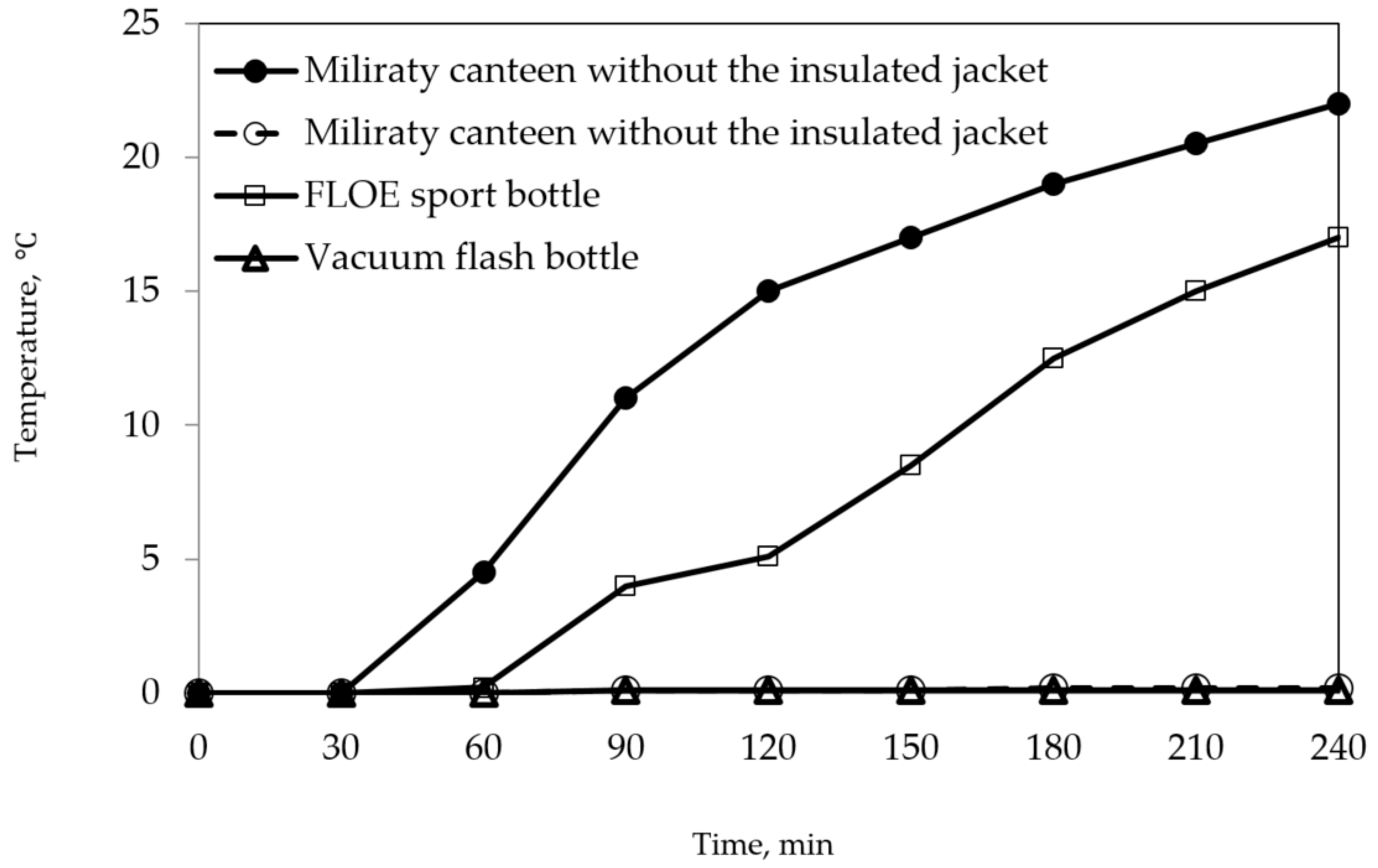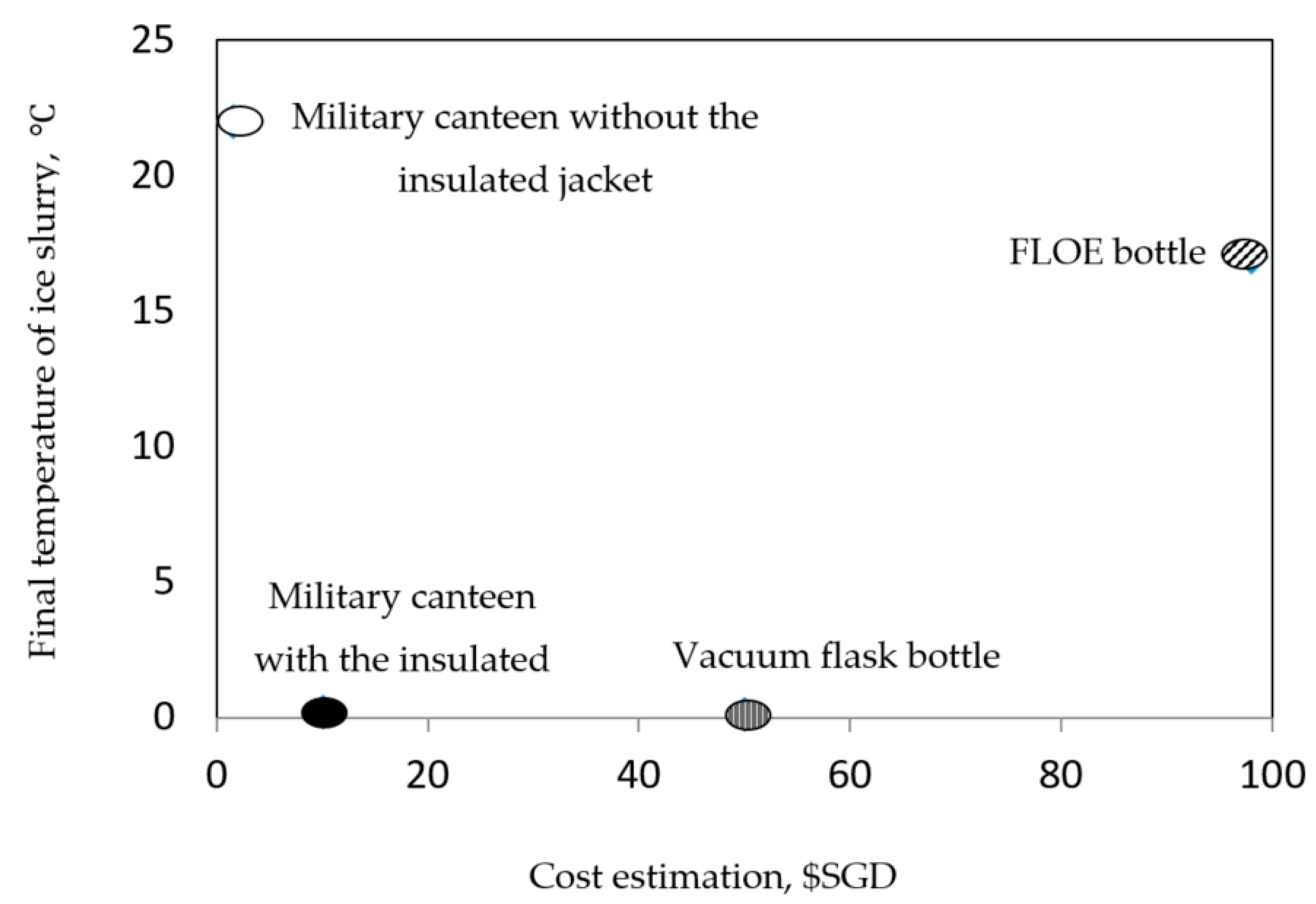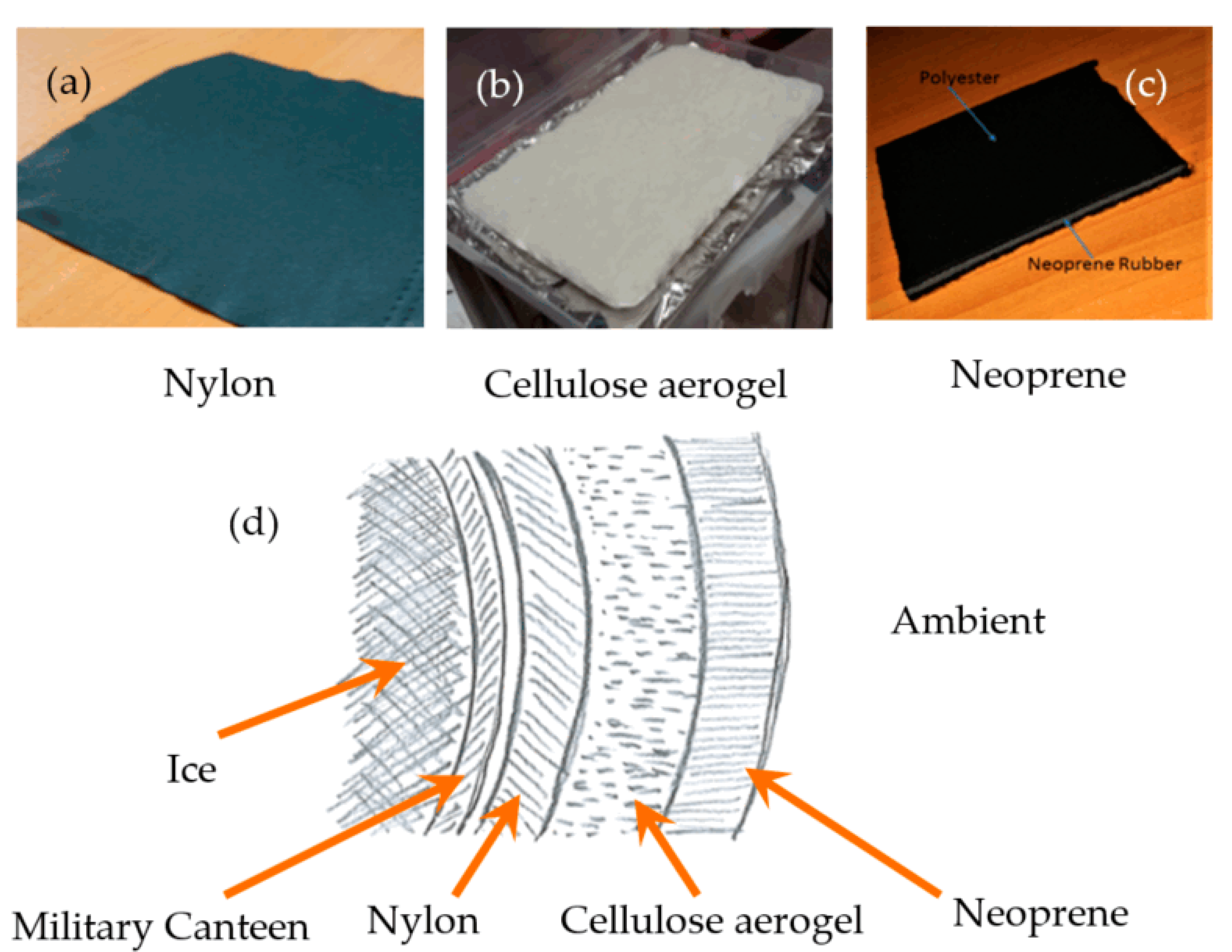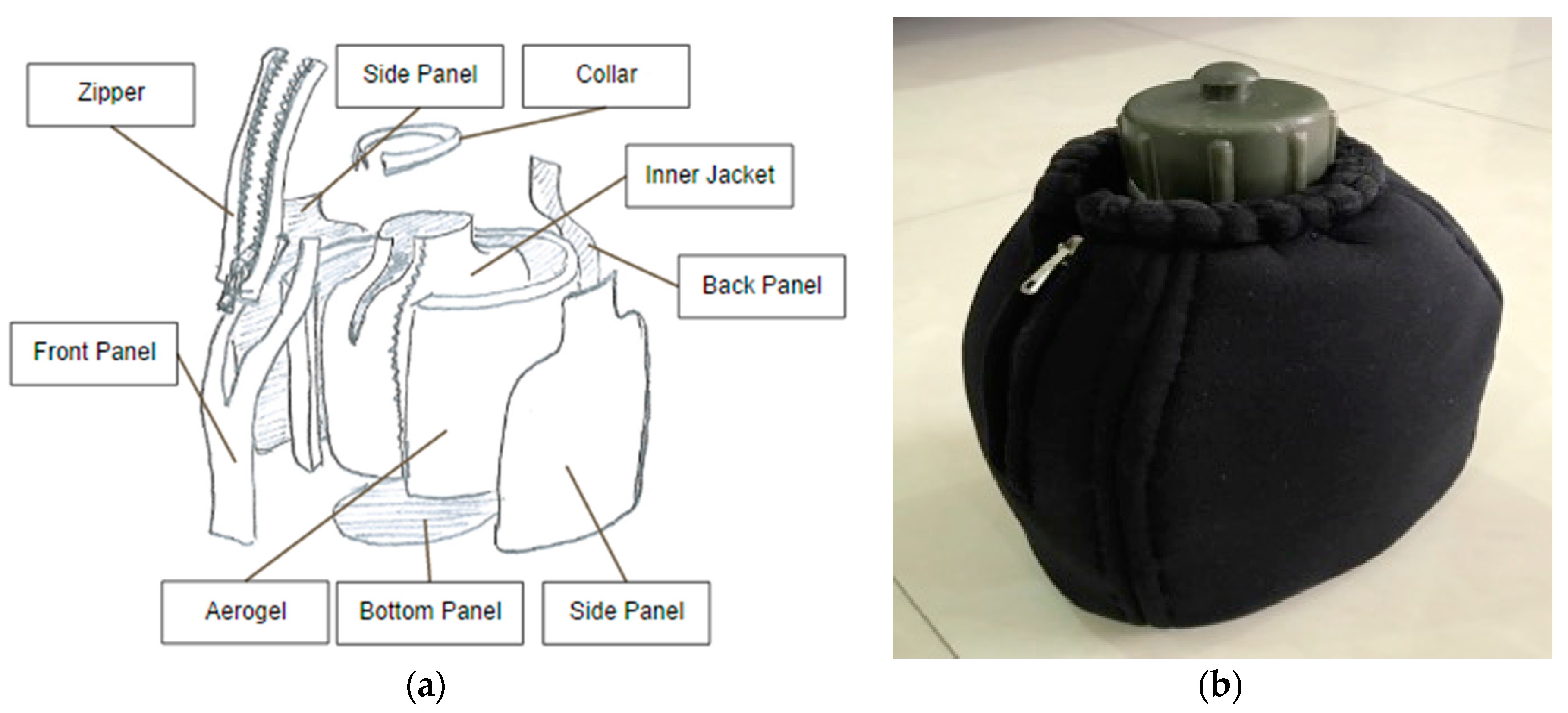Thermal Jacket Design Using Cellulose Aerogels for Heat Insulation Application of Water Bottles
Abstract
:1. Introduction
2. Results
3. Discussion
3.1. Advantages of the Developed Thermal Jacket
3.2. Limitations of Thermal Jacket Design
4. Materials and Methods
4.1. Fabrication of Cellulose Aerogels
4.2. Design of Sandwich Structures
4.3. Prototype Fabrication Process of the Thermal Jacket
4.4. Characterization
5. Conclusions
Acknowledgments
Author Contributions
Conflicts of Interest
Appendix A
| Parameters | Military Canteen [4] | Floe Bottle [6] | Vacuum Flask [5] |
|---|---|---|---|
| Thermal conductivity, W/m·K | 0.33 | 0.14 | - |
| Cost, S$ | $1.52 | $98.00 | $50.00 |
| Capacity, L | 1.0 | 1.0 | 1.0 |
| Weight, g | 160 | 500 | 900 |
| S/N | Items | Unit Cost, S$ | Quantity | Cost, S$ |
|---|---|---|---|---|
| 1 | Military Canteen Bottle | S$1.52/bottle | 1 | 1.52 |
| 2 | Polyester Fabric | S$1.40/m2 | 0.100 | 0.14 |
| 3 | Recycled Cellulose | S$4.36/kg | 0.0287 | 0.13 |
| 4 | Kymene | S$1.05/kg | 0.0057 | 0.01 |
| 5 | MTMS | S$2.24/kg | 0.143 | 0.32 |
| 6 | Zipper | S$0.46/m | 0.100 | 0.05 |
| 7 | Neoprene (3-mm thickness) | S$3.02/m2 | 0.100 | 0.30 |
| 8 | Manpower | S$2.93/h | 0.5 | 1.47 |
| 9 | Electricity | S$0.13/kWh | 47.8 | 6.21 |
| 10 | Water | S$0.73/m3 | 0.0029 | 0.05 |
| Total cost estimation | S$10.14 | |||
| Material Selection Criteria | Cellulose Aerogel [9,10,11,12] | Neoprene Fabric [14] | Nylon Fabric [13] |
|---|---|---|---|
| Thermal conductivity (W/m·K) | 0.03 | 0.047 | 0.046 |
| Density (g/cm3) [6] | 0.04 | - | - |
| Durability | Fair | Excellent | Good |
| Stretchability | Fair | Excellent | Excellent |
| Low Cost and availability | Yes but no availability in the market | Yes and availability in the market | Yes and availability in the market |
References
- Heat Stroke: Symptoms and Treatment. Available online: https://www.webmd.com/a-to-z-guides/heat-stroke-symptoms-and-treatment#1 (accessed on 1 November 2017).
- Lee, J.K.W.; Kennefick, R.W.; Cheuvront, S.N. Novel cooling strategies for military training and operations. J. Strength Cond. Res. 2015, 29, S77–S81. [Google Scholar] [CrossRef] [PubMed]
- Dugas, J. Ice slurry ingestion increases running time in the heat. Clin. J. Sport Med. 2011, 21, 541–542. [Google Scholar] [CrossRef] [PubMed]
- Seah, K.H. Fundamental Principles of Manufacturing, 1st ed.; Cobee Publishing House: Singapore, 2015; ISBN 9789810959050. [Google Scholar]
- Best Insulated Water Bottles—Our Top Picks, Hydration Anywhere. Available online: https://hydrationanywhere.com/best-insulated-water-bottle-our-top-picks/ (accessed on 1 November 2017).
- Floe Bottle. Available online: https://www.floebottle.com/ (accessed on 1 November 2017).
- Beer Koozies Do Help Keep Your Drink Cold—But Not The Way You Think They Do. Available online: http://www.ibtimes.com/beer-koozies-do-help-keep-your-drink-cold-not-way-you-think-they-do-1220253 (accessed on 1 November 2017).
- Five Most Common Thermal Insulation Materials. Available online: https://www.thermaxxjackets.com/5-most-common-thermal-insulation-materials/ (accessed on 1 November 2017).
- Feng, J.; Nguyen, S.T.; Fan, Z.; Duong, H.M. Advanced fabrication and oil absorption properties of super-hydrophobic recycled cellulose aerogels. Chem. Eng. J. 2015, 270, 168–175. [Google Scholar] [CrossRef]
- Duong, H.M.; Nguyen, S.T. Nano and Biotech Based Materials for Energy Building Efficiency; Springer International Publishing: Cham, Switzerland, 2016; pp. 411–427. ISBN 978-3-319-27505-5. [Google Scholar]
- Nguyen, S.T.; Feng, J.; Le, N.; Le, A.T.; Hoang, N.; Duong, H.M. Cellulose aerogel from paper waste for crude oil spill cleaning. Ind. Eng. Chem. Res. 2013, 52, 18386–18391. [Google Scholar] [CrossRef]
- Nguyen, S.T.; Duong, H.M.; Tan, V.B.C.; Ng, S.K.; Wong, J.P.W.; Feng, J. Advanced thermal insulation and absorption properties of recycled cellulose aerogels. Colloids Surf. A Physicochem. Eng. Asp. 2014, 445, 128–134. [Google Scholar] [CrossRef]
- Nylon vs. Polyester. Available online: http://www.diffen.com/difference/Nylon_vs_Polyester (accessed on 1 November 2017).
- Neoprene Rubber Polymer. Available online: http://www.warco.com/polymer/neoprene/ (accessed on 1 November 2017).




© 2017 by the authors. Licensee MDPI, Basel, Switzerland. This article is an open access article distributed under the terms and conditions of the Creative Commons Attribution (CC BY) license (http://creativecommons.org/licenses/by/4.0/).
Share and Cite
Duong, H.M.; Xie, Z.C.; Wei, K.H.; Nian, N.G.; Tan, K.; Lim, H.J.; Li, A.H.; Chung, K.-S.; Lim, W.Z. Thermal Jacket Design Using Cellulose Aerogels for Heat Insulation Application of Water Bottles. Fluids 2017, 2, 64. https://doi.org/10.3390/fluids2040064
Duong HM, Xie ZC, Wei KH, Nian NG, Tan K, Lim HJ, Li AH, Chung K-S, Lim WZ. Thermal Jacket Design Using Cellulose Aerogels for Heat Insulation Application of Water Bottles. Fluids. 2017; 2(4):64. https://doi.org/10.3390/fluids2040064
Chicago/Turabian StyleDuong, Hai M., Ziyang Colin Xie, Koh Hong Wei, Ng Gek Nian, Kenneth Tan, Hong Jie Lim, An Hua Li, Ka-Shing Chung, and Wen Zhen Lim. 2017. "Thermal Jacket Design Using Cellulose Aerogels for Heat Insulation Application of Water Bottles" Fluids 2, no. 4: 64. https://doi.org/10.3390/fluids2040064




